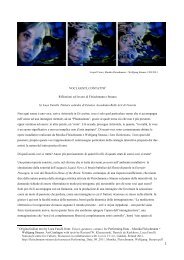Głosy, gesty, kontakt || Voices, gestures, contact
Voices, Gestures, Contact by Luca Farulli. Reflections about the work of Monika Fleischmann + Wolfgang Strauss. Luca Farulli writes about „Liquid Views“. „Liquid Views“ (1992/2013) is a simulation of artificial water in which the viewer’s reflection is portrayed as in real water. The computer as a storage media per se, artistically turned, tempts the visitor to leave its trace in the open system. Liquid Views predicts, cultural, social, technical and aesthetic changes that become evident 20 years later. In: Fleischmann, Monika; Strauss, Wolfgang: Performing Data | Performowanie danych with texts by Ryszard W. Kluszczyński, Derrick de Kerkhove (txt), Luca Farulli. National Centre for Culture, Warszawa 2011 with Laznia CCArt, Gdańsk, Poland 2011 ISBN 978-83-61587-55-2 http://fleischmann-strauss.de/resources/Luca-Farulli-VoicesGesturesContact-in-Performing_Data_2011.pdf
Voices, Gestures, Contact by Luca Farulli. Reflections about the work of Monika Fleischmann + Wolfgang Strauss.
Luca Farulli writes about „Liquid Views“. „Liquid Views“ (1992/2013) is a simulation of artificial water in which the viewer’s reflection is portrayed as in real water.
The computer as a storage media per se, artistically turned, tempts the visitor to leave its trace in the open system.
Liquid Views predicts, cultural, social, technical and aesthetic changes that become evident 20 years later.
In: Fleischmann, Monika; Strauss, Wolfgang: Performing Data | Performowanie danych with texts by Ryszard W. Kluszczyński, Derrick de Kerkhove (txt), Luca Farulli. National Centre for Culture, Warszawa 2011 with Laznia CCArt, Gdańsk, Poland 2011 ISBN 978-83-61587-55-2 http://fleischmann-strauss.de/resources/Luca-Farulli-VoicesGesturesContact-in-Performing_Data_2011.pdf
Create successful ePaper yourself
Turn your PDF publications into a flip-book with our unique Google optimized e-Paper software.
całkiem minionego: stanowi on właściwy<br />
obraz dialektyczny, w którym „to co<br />
się stało” „migocze” w teraźniejszości<br />
„poznania” 4 . Właśnie w związku z rolą<br />
zastępczą wykonywaną przez Phantasmata<br />
w stosunku do odczuć, czy też<br />
w wyniku zależności istniejącej pomiędzy<br />
obrazami mentalnymi i odczuciami,<br />
każdy akt myślenia jest powiązany z aktem<br />
wyobraźni: „Wyobrażenia bowiem są<br />
jak gdyby przedmiotami postrzeganymi<br />
z tą tylko różnicą, że są niematerialne”,<br />
pisze Arystoteles: bez nich „dusza nie<br />
myśli nigdy”, nie zastanawia się nawet<br />
nad samą sobą 5 . W takiej optyce Liquid<br />
Views przesuwa zdecydowanie zakres<br />
oddziaływania mitu Narcyza w kierunku<br />
aktu releksji, gestu wykonanego przez<br />
odbiorcę jako aktu przemyślanego, a nie<br />
tylko odbitego. Przeniesienie akcentu<br />
w recepcji mitu Narcyza staje się jasne<br />
i oczywiste w momencie, w którym odbiorca<br />
zauważa nie tylko swoje odbicie<br />
w lustrze wody, lecz także na ekranie<br />
projekcyjnym dostępnym dla wszystkich<br />
zwiedzających obecnych w pobliżu.<br />
Gra odbić funkcjonuje więc na kilku poziomach,<br />
z ważnymi implikacjami na poziomie<br />
przetwarzania własnego wyobrażenia<br />
przez odbiorcę. Pierwszy poziom<br />
ogólny – „doświadczanie siebie w doświadczeniu<br />
innych”, którego podmiot<br />
dokonuje dzięki wymiarowi „estetycznemu”,<br />
w którym działa 6 . Drugi poziom,<br />
4 Walter Benjamin, „Paryż – stolica<br />
dziewiętnastego wieku”, w: Twórca jako wytwórca,<br />
red. H. Orłowski, Poznań 1975.<br />
5 Arystoteles, „O duszy”, w: Dzieła<br />
wszystkie, tłum. P. Siwek, Wyd. Naukowe PWN,<br />
Warszawa 2003, tom III, s. 136.<br />
6 „W podejściu estetycznym – pisze Hans<br />
Robert Jauß – podmiot obcuje z czymś więcej<br />
niż z sobą samym: doświadcza samego siebie<br />
przyswajając doświadczenie sensu świata, który<br />
played by Phantasmata (phantasms)<br />
against feelings, or as a result of interdependence<br />
between mental images<br />
and feelings, that each act of thinking<br />
is related with an act of imagination:<br />
“mental images are like present sensations,<br />
except that they are immaterial,”<br />
writes Aristotle, because without them,<br />
“the soul never thinks,” 5 and it does not<br />
even reflect upon itself.<br />
Considering all that, Liquid Views dramatically<br />
shifts the scope of effect of<br />
the myth of Narcissus towards a gesture<br />
made by the viewer as a premeditated<br />
act, not a merely reflected one.<br />
Shifting the emphasis in reception of<br />
the myth of Narcissus becomes clear<br />
and evident in the moment when the<br />
viewer notices his/her reflection on the<br />
water surface, but also on the screen<br />
visible for all the visitors nearby. The<br />
play of reflections functions on a number<br />
levels, with serious implications in<br />
terms of processing the viewer’s own<br />
image. The first, general level is “experiencing<br />
oneself in a possible being other,”<br />
which the subject does thanks to the<br />
“aesthetic” dimension within which it<br />
acts. 6 The second level appears when<br />
5 Aristotle: De Anima. Transl. by<br />
R. D. Hicks, New York: Cosimo Books, 2008.<br />
93., 91. resp.<br />
6 “In aesthetic behavior, the subject<br />
always enjoys more than itself. It experiences itself<br />
as it appropriates an experience of the meaning<br />
of world which both its own productive activity<br />
and the reception of the experience of others<br />
can disclose, and the assent of third parties can<br />
conirm. Aesthetic enjoyment that thus occurs<br />
in a state of balance between disinterested<br />
contemplation and testing participation is a mode<br />
of experiencing oneself in a possible being other<br />
which the aesthetic attitude opens up...”–Hans<br />
Robert Jauß: Aesthetic Experience and Literary<br />
Hermeneutics. Trans. by M. Shaw. Minneapolis:<br />
University of Minnesota Press, 1982. 32.







